Railroad Addition Historic District (Flagstaff, Arizona)
|
Railroad Addition Historic District | |
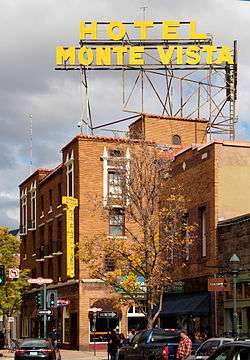 Hotel Monte Vista | |
| Location | Roughly bounded by Santa Fe RR tracks, Agassiz and Beaver Sts., Birch and Aspen Aves., Flagstaff, Arizona |
|---|---|
| Area | 17.8 acres (7.2 ha) |
| Built | 1883 |
| Architectural style | Early Commercial, Romanesque, Classical Revival |
| MPS | Flagstaff MRA (AD) |
| NRHP Reference # |
83002989[1] (original) 86001360[1] (increase 1) 97001086[1] (increase 2) |
| Significant dates | |
| Added to NRHP | January 18, 1983 |
| Boundary increases |
June 17, 1986 September 5, 1997 |
The Flagstaff Railroad Addition Historic District is significant because of its association with the Atchison, Topeka and Santa Fe Railway as well as U.S. Route 66. The original boundary was roughly bounded by Santa Fe RR tracks, Agassiz and Beaver Sts., Birch and Aspen Avenues. The district was expanded twice to add nine buildings along Phoenix Avenue from Beaver Street to San Francisco Avenue, and a building at 122 East Route 66.[2]
Disastrous fires swept through early Flagstaff; in 1897 the city passed an ordinance requiring all buildings in the business area to be built of brick, stone or iron. [3]
Several of the buildings in the District are associated with well known businessmen of the late 1800s and early 1900s. These include John W. Weatherford, who constructed the Weatherford Hotel, The Babbitt brothers David, George, William and Charles whose names are associated with several buildings in the District, and Thomas E. Pollock, Sr.[4]
| Name | Year Built | Architectural Style | Comments |
Flagstaff 1926 Depot
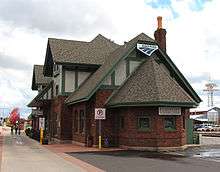 Santa Fe Depot 1926 Building, 1 East Route 66, Flagstaff, AZ |
1926 | Revival Tudor | Built during the boom years of the 1920s, and is now considered a symbol of Flagstaff. Today it is known as the Amtrak station and Visitor Center. [5] |
McMillan Building
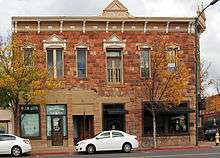 McMillan Building, Northwest corner of Route 66 and Leroux St., Flagstaff, AZ |
1886 | Hotel built out of native stone and locally made brick; bank located at corner[5] | |
Raymond Building
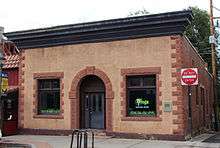 Ramond Building, 9 N Leroux St, Flagstaff, AZ |
1911 | Dr. Raymond was one of Flagstaff's earliest physicians; Moencopi sandstone around door[5] | |
Loy Building
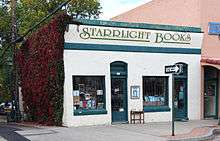 Loy Building, 15 N Leroux St, Flagstaff, AZ |
1897 | Loy was an attorney[5] | |
Citizen's Bank Building
 Citizen's Bank Building, 17 N Leroux St, Flagstaff, AZ |
1903 | Constructed of Moencopi sandstone[5] | |
Flagstaff Telephone Exchange
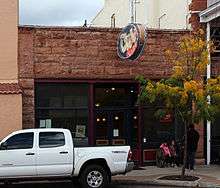 Flagstaff Telephone Exchange, 23 N Leroux St, Flagstaff, AZ |
1909 | Was the first major telephone office; built by John Weatherford; reverted to restaurant in 1930; constructed of Moencopi sandstone[5] | |
Weatherford Hotel
 Weatherford Hotel, 23 N Leroux St, Flagstaff, AZ |
First section made 1898 and second section made in 1899 | Considered to be a downtown anchor since 1900; constructed of Moencopi sandstone[5] | |
Coalter Building
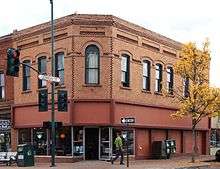 Coalter Building, 1 E Aspen Ave, Flagstaff, AZ |
1898 | Flagstaff's first Post Office[5] | |
Pollock Building
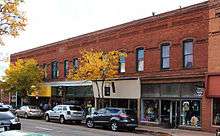 Pollock Building, series of shops at 5 E Aspen Ave, Flagstaff, AZ |
1900-1903 | Flagstaff's first library on the second floor[5] | |
Babbitt Building #1
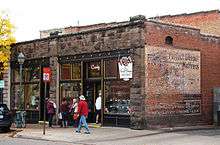 Babbitt Building 1, 15 E Aspen Ave, Flagstaff, AZ |
1907 | Flagstaff's second Post Office located here; constructed of tufa[5] | |
Babbitt Building #2
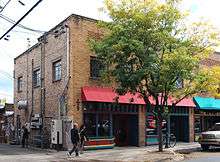 Babbitt Building #2, 10 E Aspen Ave, Flagstaff, AZ |
1911[5] | ||
Elks Hall
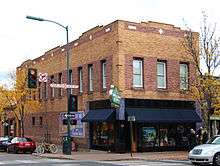 Elks Hall, 24 N San Francisco St, Flagstaff, AZ |
1899 | The Elks occupied the top floor; the first bowling alley in Flagstaff was in the basement; ground floor was a drug store[5] | |
Coconino Sun Building
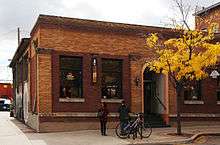 Coconino Sun Building, 111 E. Aspen Ave., Flagstaff, AZ |
1926 | The Sun Newspaper has been Flagstaff's newspaper since 1891; it was moved to this location to make room for the Monte Vista Hotel[5] | |
Bikker Building #1
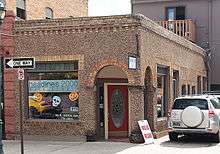 Bikker Building #1, 113 E. Aspen Ave., Flagstaff, AZ |
1917 | Originally a harness shop; unusual shell of pebble siding added later[5] | |
Bikker Building #2
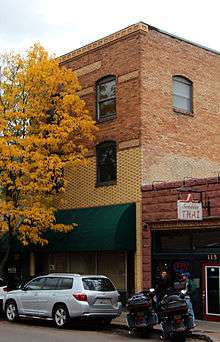 Bikker Building #2, 119 E. Aspen Ave., Flagstaff, AZ |
1917 | First floor to house J.C. Penny, the first chain to come to Flagstaff; second floor Odd Fellows hall[5] | |
Monte Vista Hotel
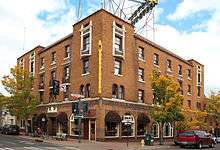 Monte Vista Hotel, 100 N San Francisco St, Flagstaff, AZ |
1926 | The construction on this hotel was a community effort, in 1926 raising $200,000 within 60 days[5] | |
Riordan Building
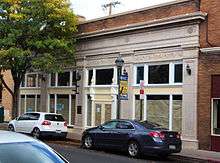 Riordan Building, 106 N. San Francisco St., Flagstaff, AZ |
1917 | Neoclassical | Flagstaff's 3rd Post Office[5] |
Babbitt Brothers Building
 Babbitt Brothers Building, 73 E Aspen Ave, Flagstaff, AZ |
1888 | Was originally a department store; it has been expanded many times, and restored to original appearance in 1990[5] | |
Babbitt's Garage
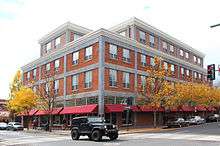 Babbitt's Garage, 175 N San Francisco St, Flagstaff, AZ |
1915 | The Babbitt brothers constructed this for automobiles, using reinforced concrete, a first for the area[5] | |
Masonic Temple
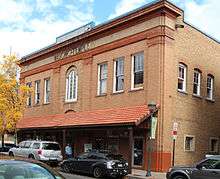 Masonic Temple, 105 E Birch Ave, Flagstaff, Arizona |
1917 | Upper story housed the temple; ground floors and basement were rentals[5] | |
Federal Building
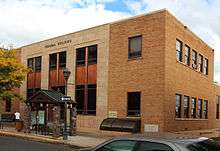 Federal Building, 123 N San Francisco St, Flagstaff, AZ |
1936 | Federal Modern style | Flagstaff's fifth Post Office[5] |
Hawks Building
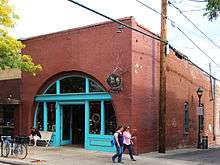 Hawks Building, 14 N San Francisco St, Flagstaff, AZ |
1897[5] | ||
Nackard Building
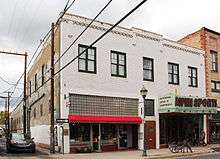 Nackard Building, 15 N San Francisco St, Flagstaff, AZ |
1922 | Location of fourth Post office[5] | |
Brannen Building #3
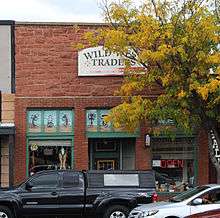 Brannen Building #3, 106 Route 66, Flagstaff, AZ |
1887 | Housed town's first physician, D. J. Brannen, who had office and drug store here[5] | |
Brannen Building #5
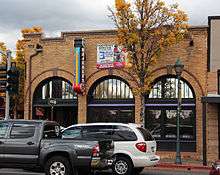 Brannen Building #5, 102 Route 66, Flagstaff, AZ |
1883 | P.J. Brannen was first store owner to set up business in Flagstaff; building burned once but was rebuilt using original stones[5] | |
Vail Building
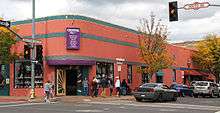 Vail Building, 3 N San Francisco St, Flagstaff, Arizona |
1888 | Art Deco | Most of Flagstaff's first businesses were saloons, catering to railroad workers; brawls and shootings were common; building made of brick, but stuccoed in 1939[5] |
Donahue Building
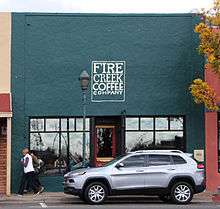 Donahue Building, 22 Route 66, Flagstaff, AZ |
1888 | Originally a saloon, and was owned by one of Flagstaff's most colorful characters, Sandy Donahue; built of brick and stuccoed in the 1930s[5] | |
Santa Fe Depot 1889
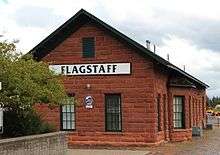 Santa Fe Depot 1889, Route 66, Flagstaff, AZ |
1889 | Flagstaff's first train depot; in 1886 wooden depot destroyed by fire; present building made of Moencopi sandstone[5] |
References
- 1 2 3 National Park Service (2010-07-09). "National Register Information System". National Register of Historic Places. National Park Service.
- ↑ James Garrison; Jody Gebhardt; James Woodward (September 1982). "National Register of Historic Places Inventory - Nomination Form: Railroad Addition Historic District" (PDF). National Park Service. Retrieved January 14, 2016. Also includes 1986 and 1997 boundary increases.
- ↑ Carl Edenhofer; Cindy Laucher; Joe Westling; Gail Bonelli (c. 1977). "National Register of Historic Places Inventory - Nomination Form: Weatherford Hotel" (PDF). National Park Service. Retrieved January 14, 2016. Accompanying three photos from 1997.
- ↑ Jim Woodward (July 1985). "National Register of Historic Places Inventory - Nomination Form: North End Historic Residential District" (PDF). National Park Service. Retrieved January 12, 2016.
- 1 2 3 4 5 6 7 8 9 10 11 12 13 14 15 16 17 18 19 20 21 22 23 24 25 26 27 28 Richard K. Mangum and Sherry G. Mangum (1993). Flagstaff Historic Walk: A Stroll Through Old Downtown (Map). Northland Printing.
| Wikimedia Commons has media related to Railroad Addition Historic District (Flagstaff, Arizona). |